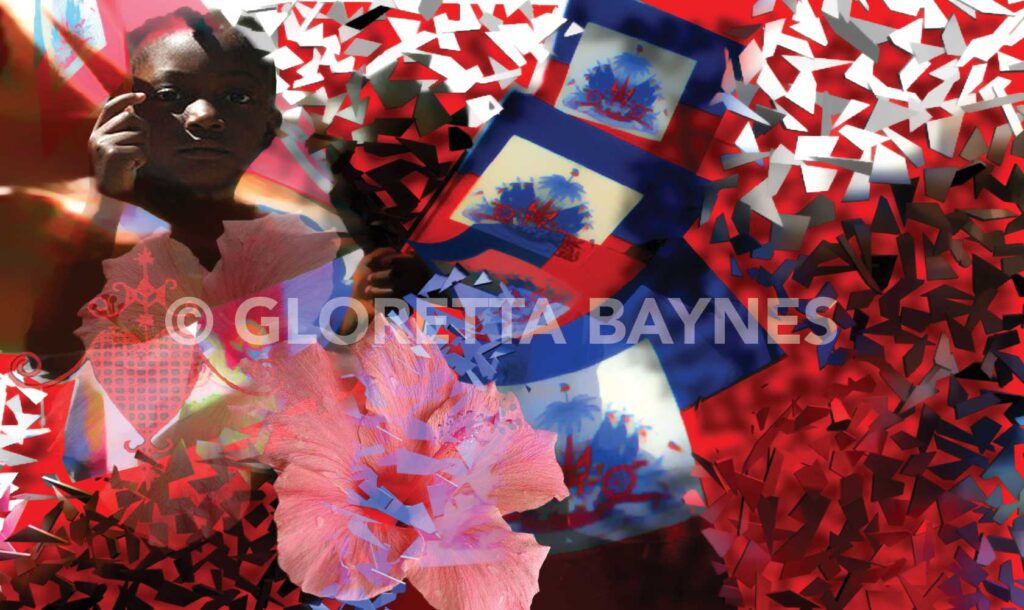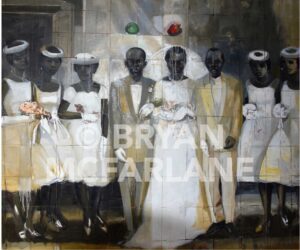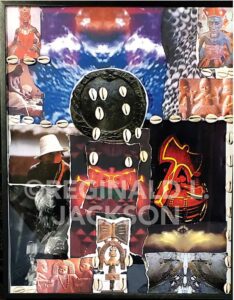
“Haiti Victorious2″ by Gloretta Baynes PHOTO: courtesy of the artist
Banner [Virtual] Art Gallery
Sponsored by City of Boston | Mayor Michelle Wu
On Thursday, May 30, the Bay State Banner and the African American Master Artists-in-Residency Program will present “Black Art in Afro-Centric Spaces,” part of the Banner [Virtual] Art Gallery Roundtable series, starting at 7 p.m. at 76 Atherton St. in Jamaica Plain.
Moderated by Ron Mitchell, Bay State Banner publisher and editor, and L’Merchie Frazier, artist and executive director of creative/strategic planning at SPOKE arts engagement program, the event will pay tribute to AAMARP founder Dana C. Chandler and feature artists from the program’s recent “Reclamation” exhibition.
Five of the evening’s featured artists who are currently in residence at AAMARP have been highlighted in the Bay State Banner’s [Virtual] Art Gallery series over the past year. Below are brief excerpts from their interviews. Also appearing at the event will be artists Larry Pierce, Gale Fulton Ross, Rob “Problak” Gibbs, Percy Fortini-Wright and Ayana Mack.
Gloretta Baynes, an artist working in airbrush, pen & ink, pencil, fabric, collage, mixed media and digital photography: “I think it’s very important to have a mentor because you need to have somebody who you can bounce things off of. They can kind of guide you through the process or just be a friend and give you an opinion, or gently guide you in a different direction — expose you to different types of things that ordinarily wouldn’t be available to you. I would say to young people, reach out to artists in the community, because it’s not like the MFA where you go and you don’t know the artist. You see their work, but you can’t interact with them. You can’t have a dialogue with them, and you can’t ask them about the process. That’s the wonderful thing about being here with AAMARP. We’re able to work with the community. We’re able to mentor young people when they come in and have those conversations. They’re in a safe space where they can do that.”
Reginald “Reggie” Jackson, an educator and visual artist working in photography and documentary film: “I come out of the understanding that when you have the tools, particularly in the arts, you need content, and that content you need to be informed about. So, I began to think more in terms of the social dynamics behind what I was doing as a documentarian. I’m much more comfortable documenting what’s going on, because … it gives me the opportunity to learn as well as to record what’s going on around me. That’s linked with community service, which is something I’ve always tried to keep in the forefront. We are here for a particular reason, and if you’re part of the community, you want to be able to contribute in a meaningful way.”

“Eggs that Hatch” (Modern Maroon Wedding), Oil on Linen, 93 x 79.5 inch, 2001, (in the Collection of Caribbean ARTCollection), by Bryan McFarlane. PHOTO: COURTESY OF THE ARTIST
Bryan McFarlane, a Jamaica-born painter and charcoal artist: “I went to China in 2007, invited by the Red Gate Gallery. I said I’d stay for a few months, but I ended up staying almost a year. I’ve been going there for at least 14, 15 years. I’ve been very productive there. What draws me to China is the discipline that I found the artists in that environment have and the way in which, as hard workers, they’re very focused. And that motivates me, too. There are many artists who are absolutely amazing. That’s part of what kept me there. Part of it also is the economic development in China. The environment is developing at a pace that has never been seen by any civilization, technically speaking. That fascinates me. As an artist, I find that amazing. The Western ideas of China are based on power politics, but I’m focused on the creative and mythological aspects of China that make art. I’ve taken the mythology — certain iconic imagery — and integrated it into my paintings. When I travel, I’m influenced by the images that I see and feel, the history and the mythology of a given culture.”
Hakim Raquib, a photographer currently exploring the digital art medium: “I think it’s important to work with young people. I’ve always worked with young people off and on as a consultant. I’ve learned from them as well. One of the reasons I got into digital art was one of my students said it’s something that’s going to happen, so you might as well jump on it. At an early age, I was empowered by people who were around me, like Dana Chandler — just totally empowered. ‘You’ve got to do this. If you believe it, do it,’ he said. I want to share that history and the shoulders that I stand on.”
Susan Thompson, a textile, fiber and mixed-media artist: “My husband would always say, ‘You should take art. You should major in art.’ But I was thinking, well, there’s no money in art, and it’s such a struggle. When we moved to Boston, I met Allan Rohan Crite, and through him, that’s how I got started, really being thrust out there into the art world. [Then] when Dana Chandler invited me into AAMARP, I was with a group of the most amazing artists. Even now, when I walk out of my studio and down the hall, I take a detour around the gallery and look at every piece of work. Being in the midst of greatness makes you better. Pursuing art is worth it if you love it. I love art. I love looking at art and making art. I love being around artists. I like talking about art. So, if you like it, I think it just touches your soul and you must do it.”









